What is a Musical Chord?
Written by: Larry Coffey

The simplest definition of a chord is three or more musical notes played at the same time.
The most common usage of chords occur in popular music, usually played on a guitar or on a piano. Most songs you hear on the radio have some sort of repeating chord structure to it – it's part of what makes it appealing to the human ear. In fact, combining a chord progression with compelling lyrics and an interesting rhythm is usually what makes the most popular of all the music today: the hit song.
Whether a song is rock, classical, jazz, or some other form of music, the chord structure is the backbone that gives the melody strength. Without chords, a song becomes unmelodious and discordant, almost atonal, lacking any harmony, figuratively and literally. Indeed, it is the pleasant, structured harmonies of a musical phrase that makes music, well, music.
Below, let us explore the technical details that make up a modern musical chord.
Table of Contents
- Conceptual Review
- Instrumentation
- Chord Structure
- Major and Minor Triads
- Sixth Chords
- Seventh Chords
- Ninth Chords
- Eleventh Chords
- Thirteenth Chords
- Other Chords
- Conclusion
Conceptual Review
Before diving into the technical aspects of a chord, let's quickly review some of the components that make up today's modern music.
Note A musical note is a single tone of a specified pitch that is sustained for a given duration. For example, pressing a single key on the piano and, assuming it is in tune, will sound a musical note. Hold the piano key for a bit, and the note will sustain until it fades. For more detailed information, visit What is a Musical Note?
Tempo The tempo of a song is the speed at which it is played, usually measured in "beats per minute". Some music, notably classical music, also have tempo and mood annotated by one or more Italian words. A few common tempo markings are: allegro (fast), lento (slow), and moderato (medium).
Octave A note that is an octave above another note is physically double the frequency of that first note. In fact, technically, octaves are just doubling or halving frequencies of a note's pitch. Both notes are given the same name, though notationally they are sometimes identified with a numerical subscript to identify which octave they belong to. For example, a concert "A" is 440 hertz. The "A" one octave above it is 880 hz, and the one below it is 220 hz.
Scale The best way to think of a scale is simply a method of traversing one octave up a piano keyboard, usually ending on the same note one octave up. There are 12 uniquely named notes within an octave, conventionally named from A up to G#, before repeating again. For more information, visit What is a Musical Scale?
Instrumentation
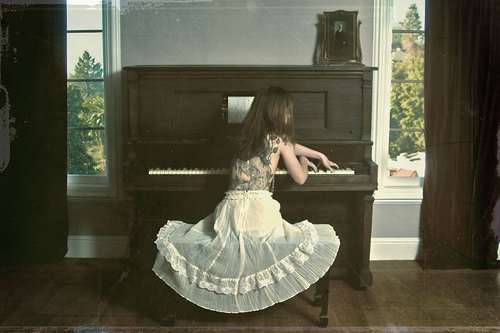
For a musical instrument to play chords, it must have the ability to play more than one note at the same time. That leaves out most wind instruments: the woodwinds, and the brass sections of the orchestra. For this capability, we must look toward the keyboard-based instruments (piano and organ) or strummed string instruments (guitar, banjo, ukelele).
A keyboard has the unique advantage of allowing us to visualize the entire range that can be played. After all, it's laid out right in front of us. And, furthermore, if we enlisted the help of enough friends' fingers, we could theoretically play every note at once.
Stringed instruments are a little more complex. Usually there is a small number of strings, tuned to a specific pitches, that can make a limited range of notes by slight shortening the string (usually with the assistance of frets). For example, a standard guitar has six strings, tuned respectively, in increasing tones to E, A, D, G, B, and E. An acoustic guitar typically has about 14 frets along the neck, allowing 14 half-steps along each string. (An electric guitar has a longer neck, and therefore a few more available half-steps.)
But what about violins, cellos, and the like? Most of the orchestra strings are constructed with a slightly arched neck that make fingering chords nearly impossible. However, it is not too uncommon for some music to be written requiring musicians to bow two strings at once.
Chord Structure
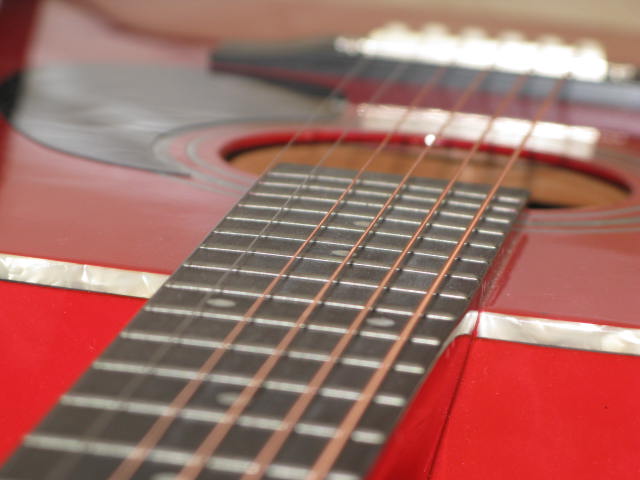
The simplest chords – those of the three note, or triad variety – are built upon their respectively named scales. Specifically, they are built on the first, third, and fifth note of that scale. For example, a C major chord is comprised of a C, E, and G, the first, third and fifth note of the C major scale. (Note: if you haven't reviewed scales yet, I highly recommend that you at least take a quick refresher by visiting What is a Musical Scale?)
Sometimes other notes will be tacked on, usually for effect or purposeful dissonance. These will usually reflect which note of the scale is added, typically the sixth or seventh, or extending the scale into the next octave, the ninth or eleventh. Furthermore, you'll usually hear terms like diminished or augmented which generally means, at least when applied to individual notes, to lower the particularly named note a half-step or to raise it a half-step, respectively. When applied to the whole chord, however, multiple notes may be affected.
But wait! There's more! After you've figured out which notes can be in a chord, those notes can actually come from any octave. They don't have to be played in scale order! In other words, the root note does not have to be played in the root position. This is called inversion.
Furthermore, each note in the chord does not have to be played only once! That's right, if you had enough fingers, and played every C on the piano, yet played only one E and one G at the same time, you'd still have a C major chord. The nearly infinite variety of chord combinations is what colors the music and gives it depth.
It's as clear as mud, right? Let's dive into some specifics to help illustrate the points. With each class of chord, I'll present the formulae for building various chords.
Major and Minor Triads
As mentioned above, a major chord is the first, third, and fifth note of the major scale. Similarly, a minor chord is the first, third, and fifth note of the minor scale. However, most people don't memorize the various scale formulae and usually remember minor chords as taking a major chord, and flattening the middle note (called a flatted third, or minor third).
In musical notation, whether it be piano music or guitar tablature, major chords are written with just their root names. Minor chords, on the other hand, are notated with a small m following the root name. For example, a C-minor chord is written as Cm.
As to be expected, there are exceptions – though extremely rare and somewhat confusing when scanning written music quickly, a major chord can be labeled with a capital M, thus making a C-major chord appear as CM. This practice is discouraged, and I only mention it here just in the rare instance that you may run into this notation sometime.
Formulae (given in half steps):
Major Chord: root 4-half 3-half
Minor Chord: root 3-half 4-half
The chords with a root C:
C Chord: C E G
Cm Chord: C Eb G
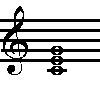 C
C
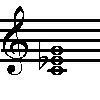 Cm
Cm
Sixth Chords
An added sixth chord is just what it sounds like: the sixth note of the major scale is added onto a triad. However, an interesting thing happens when you add a sixth onto a major triad: it becomes the root's relative minor's seventh chord (sevenths are discussed below). For example, a C6 chord contains the same notes as an Am7 chord.
A relative minor has the same key signature as a given major key. You can find the relative minor by taking the sixth note of the major scale as the starting point for a minor scale. For example, the relative minor of C is an A-minor.
Unlike the major sixth, a sixth built upon a minor triad has a relatively unique indentity. A minor sixth chord is most often found in Jazz, giving a slightly melancholy unresolved tension to the melody.
Formulae (given in half steps):
Major Sixth Chord: root 4-half 3-half 2-half
Minor Sixth Chord: root 3-half 4-half 2-half
The chords with a root C:
C6 Chord: C E G A
Cm6 Chord: C Eb G A
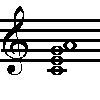 C6
C6
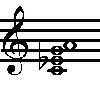 Cm6
Cm6
Seventh Chords
Beyond the major and minor chords, seventh chords are the next most used chords in modern music. They give the music a slight tension, a slight excitement, that pleasantly resolves to the root in a chord progression.
As would be expected, the seventh chord is so named by the addition of the seventh note of the major scale. What may be unexpected, however, is that the most common version – the dominant seventh – uses a flatted seventh. For example, in a C-major scale, the seventh note is a B (natural). However, the prevalent C7 chord, contains a Bb.
When annotating the seventh chord, the dominant version is assumed. So a C7 is really a C Dominant Seventh, while a major seventh, the one with the natural B, would use the maj label.
Formulae (given in half steps):
Dominant Seventh Chord: root 4-half 3-half 3-half
Minor Seventh Chord: root 3-half 4-half 3-half
Major Seventh Chord: root 4-half 3-half 3-half
Major Minor Seventh Chord: root 3-half 4-half 3-half
The chords with a root C:
C7 Chord: C E G Bb
Cm7 Chord: C Eb G Bb
Cmaj7 Chord: C E G B
Cmmaj7 Chord: C Eb G B
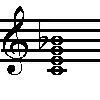 C7
C7
 Cm7
Cm7
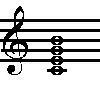 Cmaj7
Cmaj7
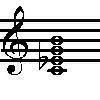 Cmmaj7
Cmmaj7
Ninth Chords
A typical ninth chord is built by adding the second note of the scale, one octave up, to a seventh chord. The most common are called the dominant ninth (built on the dominant seventh chord) and the minor ninth (build on the minor seventh chord). Less common is the more direct added ninth chord, which omits the seventh, simply building on the major or minor triad.
The annotation is similar to the seventh, with the dominant seventh assumed. Like the seventh, if the major seventh is included, then the maj label is given. The added ninth is indicated by the add label.
Formulae (given in half steps):
Dominant Ninth Chord: root 4-half 3-half 3-half 4-half
Minor Ninth Chord: root 3-half 4-half 3-half 4-half
Major Ninth Chord: root 4-half 3-half 4-half 3-half
Minor Major Ninth Chord: root 4-half 4-half 3-half 3-half
Major Added Ninth Chord: root 4-half 3-half 7-half
Minor Added Ninth Chord: root 3-half 4-half 7-half
The chords with a root C:
C9 Chord: C E G Bb D
Cm9 Chord: C Eb G A Bb D
Cmaj9 Chord: C E G B D
Cmmaj9 Chord: C Eb G B D
Cadd9 Chord: C E G D
Cmadd9 Chord: C Eb G D
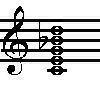 C9
C9
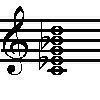 Cm9
Cm9
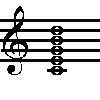 Cmaj9
Cmaj9
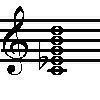 Cmmaj9
Cmmaj9
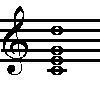 Cadd9
Cadd9
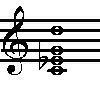 Cmadd9
Cmadd9
Eleventh Chords
A typical eleventh chord – which is anything but typical – is built by adding the fourth note of the scale, one octave up, to a ninth chord. More common, is the suspended chord version which will omit the third (and sometimes the fifth) to reduce the dissonance.
Like the seventh and ninth chords, standard annotation assumes the the dominant seventh. Since omitting the third can create what's called a suspended fourth chord, elevenths may be enharmonically indicated by the sus4 label.
Formulae (given in half steps):
Dominant Eleventh Chord: root 4-half 3-half 3-half 4-half 3-half
Minor Eleventh Chord: root 3-half 4-half 3-half 4-half 3-half
Suspended Fourth Chord: root 5-half 2-half
The chords with a root C:
C11 Chord: C E G Bb D F
Cm11 Chord: C Eb G A Bb D F
Csus4 Chord: C F G
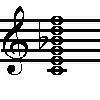 C11
C11
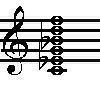 Cm11
Cm11
 Csus4
Csus4
Thirteenth Chords
Thirteenth chords are monster chords, with more notes and variations than many scales. The most basic thirteenth is constructed by adding the sixth note of the scale, one octave up, to an eleventh chord. Since a true thirteenth chord has seven notes to it, a typical guitar, with only its six strings, is incapable of even playing it. For that reason, guitar chord charts typically omit the fifth and the ninth intervals from the chord.
Formulae (given in half steps):
Dominant 13th Chord: root 4-half 3-half 3-half 4-half 3-half 4-half
Minor 13th Chord: root 3-half 4-half 3-half 4-half 3-half 4-half
The chords with a root C:
C13 Chord: C E G Bb D F A
Cm13 Chord: C Eb G A Bb D F A
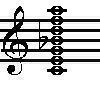 C13
C13
 Cm13
Cm13
Other Chords
Some less common chord structures:
| Chord | Enharmonic | C Root | Formula (in half steps) |
|---|---|---|---|
| (Root)aug6 | (Relative minor)maj7 | C E G# A | root, 4, 4, 1 |
| Hendrix Chord | Dominant 7(#9) | C E G Bb Eb | root, 4, 3, 3, 5 |
| Mu Chord | Add 2 | C D E G | root, 2, 2, 3 |
| Mystic Chord | Prometheus Chord | C F# Bb E A D | root, 6, 4, 6, 5, 5 |
| (Root)dim7 | C Eb Gb A | root, 3, 3, 3 | |
| (Root)maj+7 | C E G# B | root, 4, 4, 3 |
Conclusion
Congratulations! You are ready to build your own chords now. Try them out, on a piano or a guitar, and hear how they sound. What makes chords really work, though, is to put them together in sequence: into a Chord Progression.
Have fun!
Photo Credits:
Piano Keys by Nina Matthews Photography
Player Piano by Nina Frazier
If I Strum A Chord... by Sara Evans
